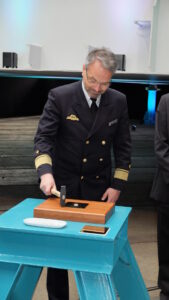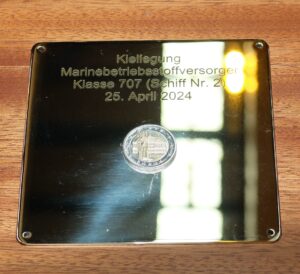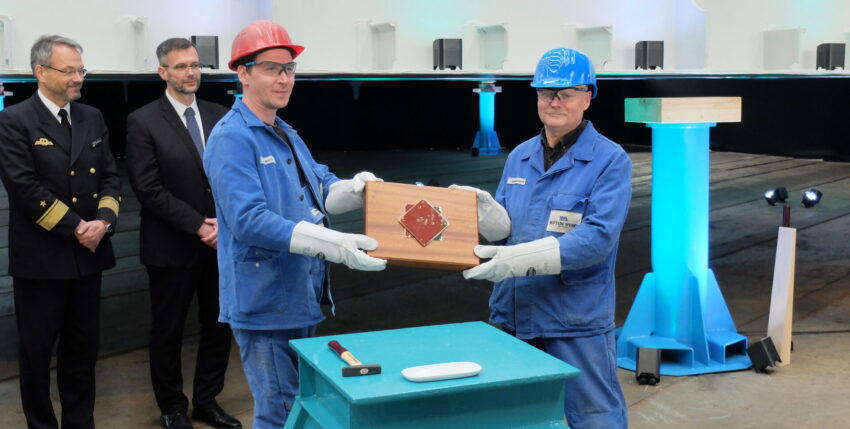On 25 April, the keel laying ceremony for the second class 707 naval fuel supply vessel was held at the Neptun shipyard in Rostock.

The ancient shipbuilding tradition of hammering a coin into the keel of a ship is said to have existed thousands of years ago, as coins were found under old ship masts during excavations. This is said to bring good voyages and good luck to the ship and crew at all times.
Not quite as long - but quite a while - the navy has been waiting for a replacement for the outdated Rhön-class fuel supply vessels. These single-hull tankers are still doing their duty, thanks to professional and motivated crews, but over time their operation has not only become expensive, but also occasionally questionable. The project team was all the quicker: the collaboration between NVL and Meyer Werft brings a breath of fresh air to the business. Just 178 days after the start of firing, a major step has now been taken. In the presence of Tim Wagner, CEO of NVL Group, and Jan Meyer from the MEYER Group in Papenburg, shipbuilders from the traditional Rostock shipyard were able to hammer the keel laying plate between the keel block girder and the steel section weighing more than 150 tonnes. Before that, the hammer blows echoed through the hall, with which the nails fastened the coin plate to the wooden block.
Flotilla Admiral Andreas Czerwinski from the Federal Office of Bundeswehr Equipment, Information Technology and In-Service Support (BAAINBw) in Koblenz, who had travelled to the event as a representative of the "ÖAG" (public contracting authority), was particularly pleased. The keynote speakers Tim Wagner and Andreas Czerwinski emphasised how important it was for them to deliver the urgently needed ships on time. Serious expressions could also be seen at the ceremony. Terms such as "LV/BV" (national and alliance defence) and the current crises, especially in maritime scenarios, make it clear that this is not just about two new naval vessels for the sustainability of our task forces on the high seas, but that the urgent security policy situation is also driving us to achieve success in a timely manner. Jan Meyer from the Meyer Group, previously less well known as a contractor for naval vessels, emphasised the pragmatism and solution-oriented production required in shipbuilding today. Nobody said a word about the order volume and the costs for the two ships, which had caused heated debate in the run-up to the event. It was also Flotilla Admiral Czerwinski who was the first to nail the brass plates to the wooden board with coins placed between them. This was then hammered under the section. Meanwhile, the guests were able to fortify themselves and enjoy the warm blankets in the cool hall.
To round off the event, interested guests were then given a tour of the first of the two 173-metre-long naval units, which will displace 20,000 tonnes and, as modern double-hull tankers, have a cargo volume of up to 13,000 cubic metres of fuel. You can read the impressive impressions in the next issues of the marine forumincluding a technical article about the new class.

For the NVL Group, the MBV project is one of several naval projects in surface shipbuilding. The second batch of Class 130 corvettes is also currently being built for the German Navy. The christening of the "Karlsruhe" as the third of the new corvettes is expected in the coming weeks. NVL is also involved in the production of the new Class 126 frigates together with the Dutch Damen Group. In the background to the event, there was news that six frigates are now being planned instead of four. This would be an enormous step for the Navy's order situation, both operationally and in terms of availability, and would be in line with the German Navy's 2035+ targets.











One Response
It's about time our safety is at risk.